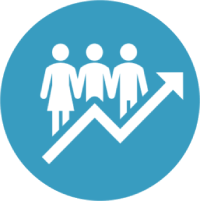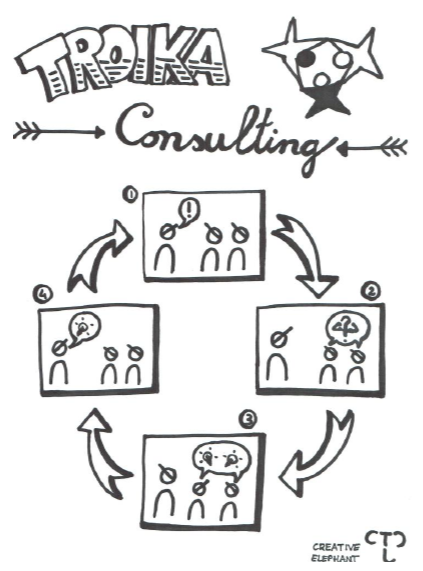
Coaching
One of the things a Scrum Master does is coaching of individuals, teams and the organization. This category gives you several ideas and techniques that help you to become an even better coach.
Besides being a teacher and a facilitator, a Scrum Master is also a coach. As a coach the Scrum Master helps people and teams to improve their skills and reach their maximul potential.
By asking porwerful questions, listening and reflecting, the Scrum Master helps people becoming aware of their own behaviour and how it affects the team.
Besides the individuals and the team, the Scrum Master also coaches the Product Owner and the larger organization.
3 Coaching Levels
As a Scrum Master (or Agile Coach) you are a coach on three levels of an organization.
Individual coach: You focus on coaching people. Help them in their personal development and with their role in the team.
Team coach: You focus on developing teams and the eco system. You help teams to become a better and tighter team.
Leadership coach: You focus on culture change of he organization and coach management in their agile leadership.
Powerful Questions
“Powerful questions are a reflection of committed listening and understanding the other
person’s perspective that is confirmed through paraphrasing. This suggests a progression
from listening, paraphrasing for understanding, and then asking powerful questions that yield
clarity or mediation of thinking” (Kee et al., 2010, p. 62).
Powerful questions are:
- Open-ended questions with no hidden agenda.
- Meant to help the receiver of the question.
Further reading about powerful questions.
Download a chart of powerful questions through a conversation.
Read many types and examples of powerful questions.
5W+1H questions
To help you ask powerful questions you can use this mnemonic. By asking questions that shart with Who, What, Where, Why and How? you can get a clear picture of the entire problem you are investigating.
Further reading and examples of 5W1H.
5 Whys
5 Whys is an iterative interrogative technique used to explore the cause-and-effect relationships underlying a particular problem. By continuing to ask “Why” five times you will come to the root cause of the problem.
Further reading with examples of 5 whys.
Clean Language
Clean Language questions are bias-free questions. By taking away presuppositions the questions become clean and without bias. They help people to develop their personal perceptions. Simple to learn, but tricky to implement, clean questions require transparency and sharing a bit more of one’s thinking than usual. The questions use the persons own words. This lets them explore their own experience further.
Further reading with a complete breakdown of example questions to create clean questions.
An example conversation with the use of clean language.
Conflict Handling
Conflict is often seen as a sign that people on a team are actively involved in the team. Generally, conflicts are resolved effectively when team members try to explore issues and possible solutions and listen carefully to the other members in the team. Positive and assertive approaches help resolve a conflict peacefully, with non-confrontational discussions.
Often, after resolving a conflict a team comes out stronger and better in working together. This is part of Tuckman’s stages of group development.
Read about an example of steps you can take to mitigate a conflict, including different techniques as 1-2-4-all Liberating structure and eventually call in external help.
Troika Consulting is a simple ‘peer support’ participation format. Set up in groups of three (troikas), everyone gets to get some free support on an issue they’re facing. And the support givers become the support receiver in one of the three rounds of consulting.
How does it work?
In short: one person, the client, asks a question or states the challenge he/she is facing. Two others in the group hold a conversation where they come up with possible solutions.The client is only listening to the conversation. Finally the client shares valuable insights they heard and ask carifying questions. This is repeated three times so that everyone in the group gets to be the client once.
View a youtube video with more explanation.
Read about Troika consulting on the website of Liberating structures.

NLP - Neuro Linguistic Programming
De methodiek NLP (Neuro Linguïstisch Programmeren) komt voort uit het bestuderen van mensen met uitzonderlijke kwaliteiten of bekwaamheden. In die studie werd heel praktisch gekeken naar welke gedachtepatronen, emoties en gedrag naar succes leidde en welke juist niet. Ook werd er onderzocht welke onbewuste strategieën ons motiveren, onze creativiteit stimuleren en ons in mogelijkheden laten denken en welke ons remmen of tegenhouden.
We nemen allemaal dezelfde buitenwereld waar via onze zintuigen. Maar waarom reageert toch iedereen anders op de buitenwereld? Via een intern proces worden deze zintuiglijke waarnemingen omgezet in communicatie en gedrag. Dit proces van waarneming tot gedrag wordt weergegeven in het NLP communicatiemodel.
Op basis van onze waarneming en de filtering van de informatie, vormen we dagelijks vanuit terugkerende gedachtepatronen ons gedrag. Onze gedachtepatronen zijn opgebouwd uit beelden, geluiden, gevoelens, interne dialoog, geur en smaak. We filteren alle informatie die we ontvangen door onbewust dingen weg te laten, te vervormen en te generaliseren. Onze gedachten en stemming sturen ons gedrag, of dit nu wel of niet op feitelijke waarneming berust of vanuit onze terugkerende patronen.
Als je NLP toepast, word je je bewust van je waarnemingen, gedachtepatronen en gedrag, zodat je waar nodig blijvende veranderingen in je communicatie en gedrag kunt maken en tot betere resultaten kunt komen.
NLP leren en toepassen, gaat over het ontdekken ‘hoe’ jij de dingen doet die je doet en hoe je (indien gewenst) deze kunt veranderen. Hoe reageer jij (communicatie en gedrag) op dat wat je waarneemt en hoe zou je dat effectiever of anders kunnen doen? NLP helpt je in je persoonlijke ontwikkeling. Je krijgt een goed idee wie je zelf bent, hoe je denkt en hoe je de dingen doet die je doet. Het leert je op een fijne manier scherper en helder naar “zaken” te kijken zodat je kunt kiezen hoe je reageert. Je leert om anders met emoties om te gaan en zo het gevoel te krijgen dat je niet meer door emoties wordt “overvallen”.
Systemic Coaching
The team is a system, living in an organizational context that’s also a system. Systems Thinking has demonstrated the power of not just looking at elements of a system but also at the relationships and interactions between them. Systemic coaching helps individuals and teams to align personal goals with organizational goals. It addresses each individual as a unique part of a larger system. And it focusses on maximizing the outcomes for the organization as a whole.
How do you get a complete view of the system?
You can get a complete picture of the system you are working in by having the people draw it out together. An introduction to this exercise is made by drawtoast.com. As a coach you can help by asking powerful questions to get a clear picture of the nodes, relations and interactions of a system
Read more about systemic coaching and systemic team coaching.
